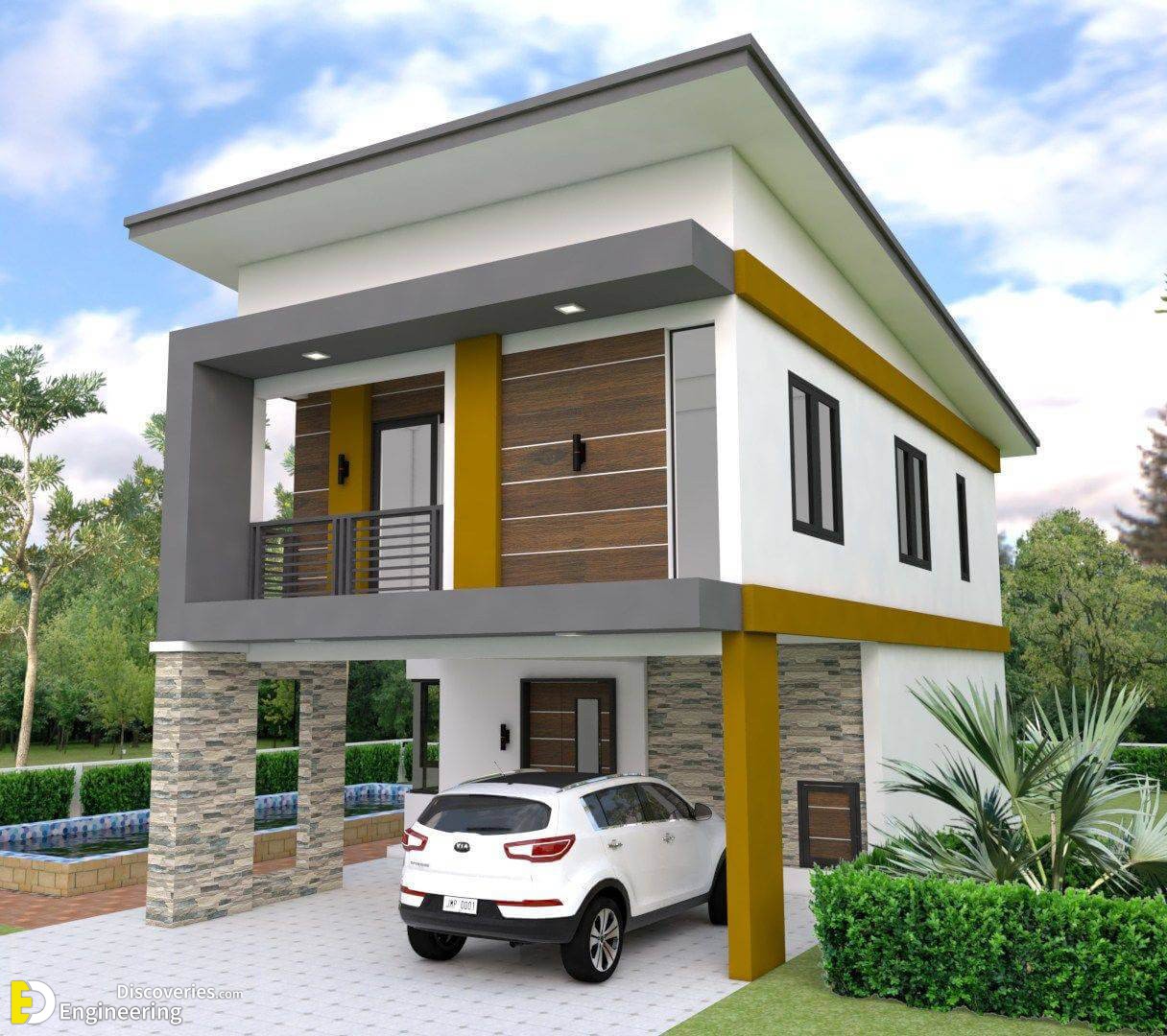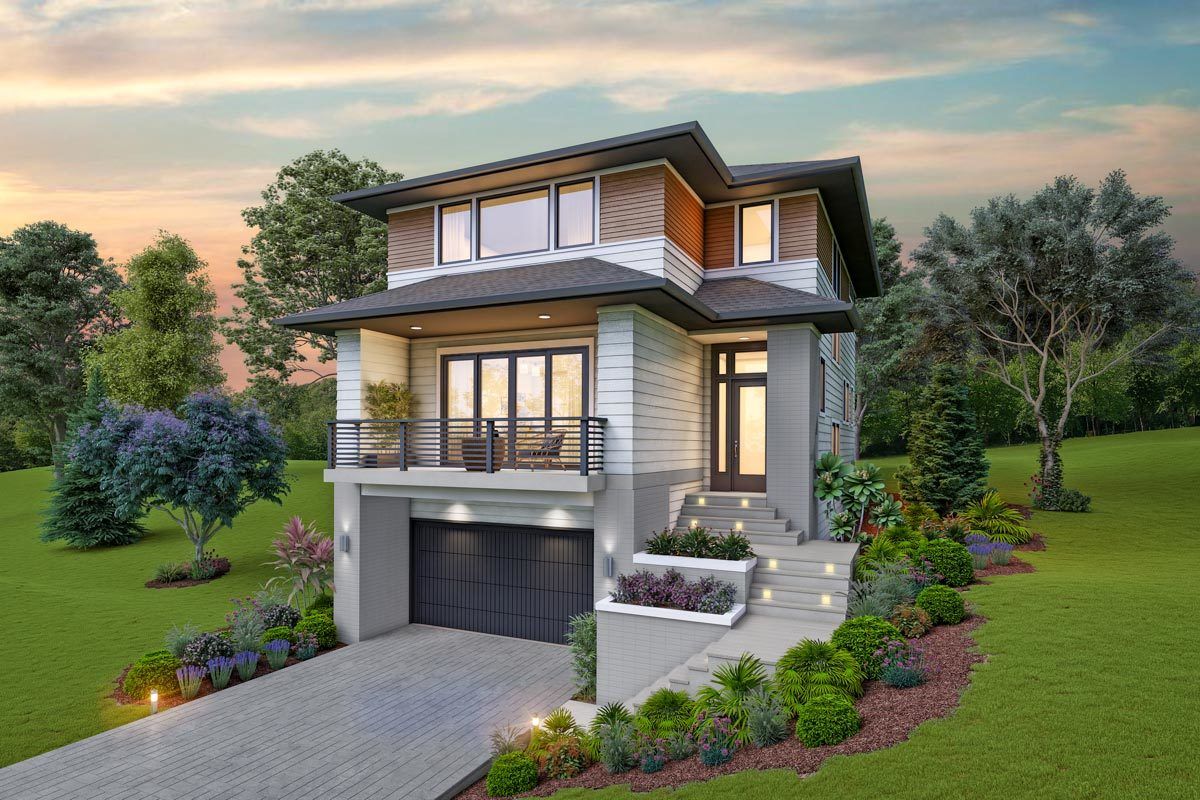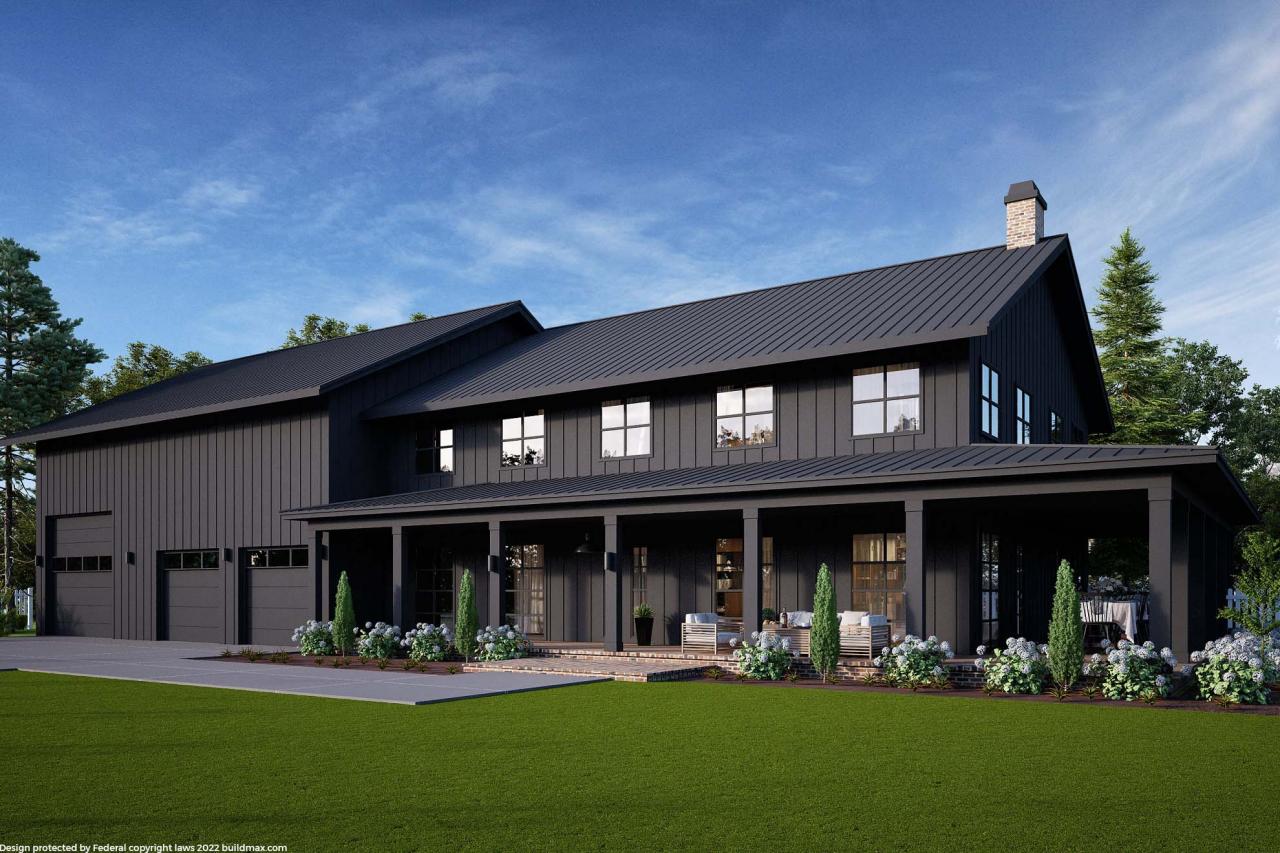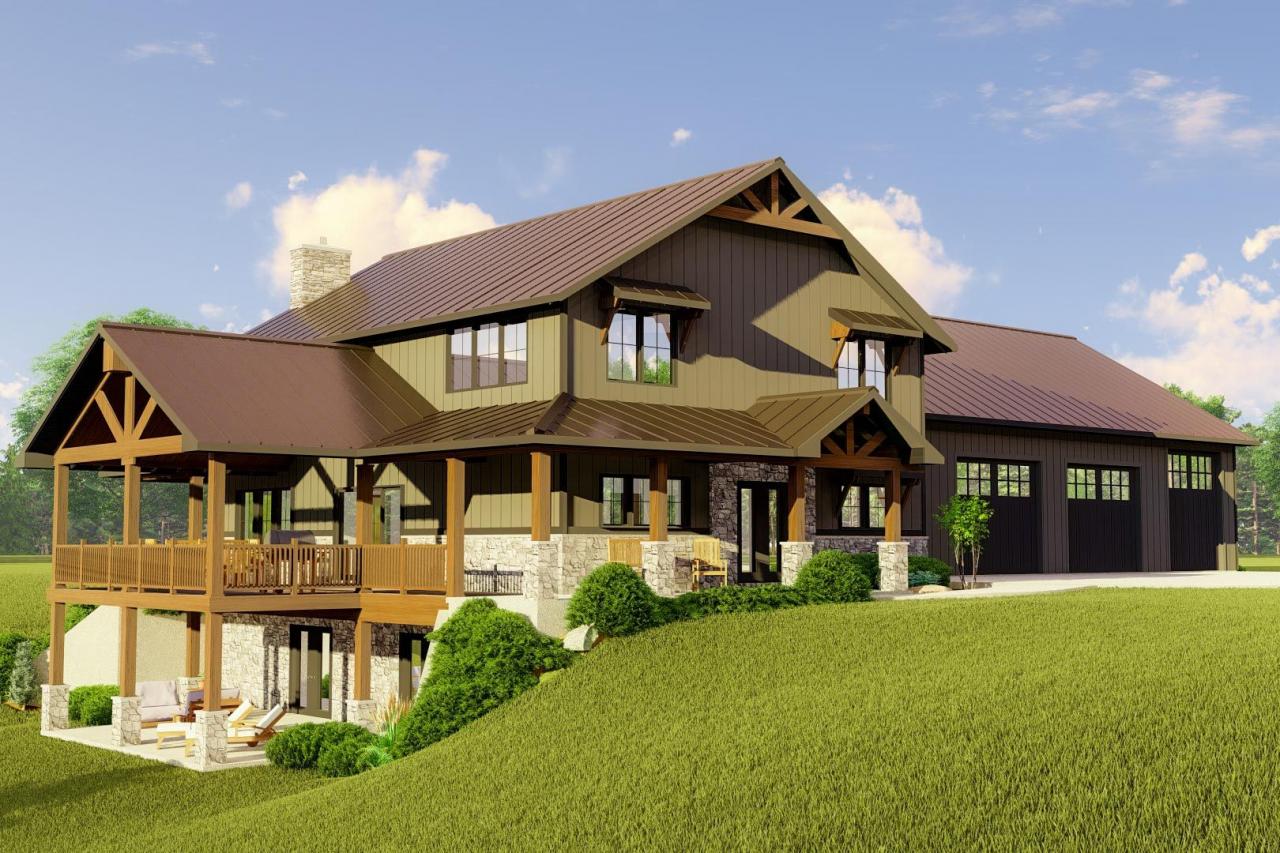Home design plans for a two story house with a garage – Home design plans for a two-story house with a garage: Dreaming of the perfect family home? This comprehensive guide dives deep into the exciting world of designing your ideal two-story house, complete with a garage. We’ll explore various floor plans, garage integration styles, stunning interior designs, and exterior landscaping options to help you visualize and build your dream home.
Get ready to unlock the possibilities and create a space that perfectly reflects your lifestyle and aspirations.
From the layout of bedrooms and bathrooms to the aesthetic of the exterior and the functionality of the garage, we’ll cover everything you need to consider. We’ll analyze different architectural styles, sustainable building practices, and even offer tips on maximizing your garage space. Whether you envision a modern minimalist haven or a cozy farmhouse retreat, this guide provides the inspiration and practical advice you need to embark on your home-building journey.
Exploring Two-Story House Layouts: Home Design Plans For A Two Story House With A Garage

Designing your dream two-story home involves careful consideration of space, flow, and family needs. This exploration delves into five distinct floor plan options, each offering a unique approach to maximizing functionality and comfort within a two-story structure, complete with a two-car garage. We’ll analyze their strengths and weaknesses, helping you visualize which layout best suits your lifestyle.
Five Two-Story House Floor Plans with Two-Car Garage
Below are five distinct floor plans, each showcasing a different arrangement of rooms and garage placement. Dimensions are approximate and can be adjusted to suit your specific lot and preferences. Remember, these are just examples, and a professional architect should be consulted for personalized designs.
| Floor Plan | Dimensions (approx.) | Bedrooms/Bathrooms | Garage |
|---|---|---|---|
| Plan A: Traditional Layout | 30ft x 40ft | 4 Bedrooms, 3 Bathrooms | Attached, rear-entry, two-car |
| Plan B: Master Suite Downstairs | 35ft x 45ft | 4 Bedrooms, 3 Bathrooms | Attached, side-entry, two-car |
| Plan C: Open Concept Living | 32ft x 42ft | 3 Bedrooms, 2.5 Bathrooms | Attached, front-entry, two-car |
| Plan D: Side-Load Garage | 35ft x 38ft | 3 Bedrooms, 2 Bathrooms | Attached, side-load, two-car |
| Plan E: Multi-Generational Design | 40ft x 45ft | 5 Bedrooms, 3.5 Bathrooms | Detached, two-car |
Advantages and Disadvantages of Each Floor Plan
Each floor plan caters to different family needs and lifestyles. Careful consideration of these factors is crucial before making a final decision.Plan A (Traditional Layout): Offers a classic layout with bedrooms upstairs and the master suite often larger. Advantages include separation of living and sleeping areas. Disadvantages may include less privacy for downstairs occupants.Plan B (Master Suite Downstairs): Ideal for aging parents or those who prefer single-story living.
Advantages include easy access and convenience. Disadvantages might be a lack of upstairs privacy if other bedrooms are smaller.Plan C (Open Concept Living): Provides a spacious and airy feel, ideal for smaller families or those who love entertaining. Advantages include a sense of openness and connection. Disadvantages might include less privacy between living areas.Plan D (Side-Load Garage): Maximizes curb appeal and yard space.
Advantages include aesthetic benefits and potentially easier access to the garage. Disadvantages might include less convenient access to the house from the garage.Plan E (Multi-Generational Design): Offers separate living quarters for multiple generations, fostering independence while maintaining proximity. Advantages include accommodating extended families. Disadvantages include potentially larger square footage and increased construction costs.
Garage Integration and Design

Choosing the right garage design is crucial for both functionality and aesthetics in a two-story home. The integration style significantly impacts accessibility, cost, and the overall curb appeal of your property. Let’s explore three common options: attached, detached, and partially attached garages.
Attached Garages
Attached garages share a common wall with the house, offering direct interior access. This design typically involves a shared foundation and roofline, simplifying construction and potentially reducing costs compared to detached options. Structural elements include a shared wall with the house, a common roof structure (often extending the house’s roofline), and a direct interior access door. The advantages include convenience and protection from the elements.
However, potential drawbacks include a slightly higher risk of fire spreading from the garage to the house and a less flexible layout if the garage size needs alteration later.
Detached Garages, Home design plans for a two story house with a garage
Detached garages are independent structures situated separately from the main house. They typically have their own foundation, roof, and utilities. Structural elements are completely independent from the main house structure. The advantages of a detached garage include increased fire safety, soundproofing, and potential for greater flexibility in design and placement. However, detached garages generally cost more to build due to the need for separate foundations, utilities, and potentially longer driveways.
Accessibility is also a factor, requiring more walking distance to and from the house.
Partially Attached Garages
Partially attached garages combine features of both attached and detached designs. They share a common wall with the house but maintain a separate roofline and potentially a separate entrance. Structural elements consist of a shared wall with the house, but independent roof structures. This offers a balance between convenience and separation. This design can offer a compromise between the advantages and disadvantages of fully attached and detached garages, allowing for some shared structural elements to reduce costs while maintaining a degree of separation for safety and aesthetic appeal.
Designing a two-story house with a garage? It’s a big project, but visualizing your dream home is easier than you think! Check out some amazing options using readily available affordable 3D home design software for beginners to bring your plans to life. From floor plans to exterior views, these tools help you perfect your two-story garage home design before breaking ground.
Maximizing Garage Space
Efficient garage space utilization is key, especially in smaller homes. Strategic storage solutions can significantly enhance functionality.
Here are some examples of how to maximize your garage space:
- Overhead Storage Racks: Install overhead racks to store seasonal items, luggage, or rarely used tools, freeing up valuable floor space.
- Wall-Mounted Cabinets and Shelving: Utilize vertical space with wall-mounted cabinets and shelving units for organizing smaller items and tools.
- Rolling Tool Cabinets: Mobile tool cabinets allow for easy access and reorganization of tools and supplies, making them ideal for smaller garages.
- Pegboards: Pegboards are a versatile option for hanging tools, sporting equipment, and other items, keeping them organized and readily accessible.
- Garage Door Organizers: Utilize the back of the garage door with organizers to store smaller items such as rakes, shovels, or brooms.
Interior Design Considerations

Transforming your two-story house plan into a dream home involves careful consideration of interior design. The style you choose will significantly impact the overall feel and functionality of your space, reflecting your personal taste and lifestyle. This section explores three distinct interior design styles – modern minimalist, traditional, and farmhouse – showcasing how each can be implemented in a two-story home with a garage.
Modern Minimalist Interior Design
Modern minimalist design prioritizes clean lines, functionality, and a sense of spaciousness. The color palette typically features neutral tones like white, gray, and beige, accented with pops of bolder color in artwork or accessories. Materials are sleek and uncluttered, often incorporating concrete, glass, and polished metals. Furniture is simple, functional, and multi-purpose, with a focus on quality over quantity.
Living Room: Imagine a spacious living room bathed in natural light from large windows. A neutral-toned sofa sits against a white wall, complemented by a low-profile coffee table made of polished concrete. Minimalist artwork hangs above the sofa, providing a subtle pop of color. The overall impression is one of airy elegance and calm.
Kitchen: The kitchen features sleek, handleless cabinetry in matte white, paired with stainless steel appliances. A large island serves as both a prep area and a casual dining space. The backsplash is a simple, clean white tile, allowing the focus to remain on the clean lines of the cabinetry and appliances.
Planning a two-story house with a garage? Consider incorporating smart design choices to maximize space and functionality. For inspiration on sustainable living, check out this guide on classic modern home design with a focus on energy efficiency which offers great ideas for energy-saving features. These principles can easily be adapted into your two-story home plans, resulting in a stylish and eco-friendly home.
Master Bedroom: The master bedroom is a sanctuary of calm. A platform bed with a simple headboard sits center stage, flanked by sleek bedside tables. Natural light streams in through large windows, highlighting the clean lines of the room. A muted gray rug anchors the space, adding a touch of texture.
Traditional Interior Design
Traditional interior design evokes a sense of warmth, comfort, and timeless elegance. Rich, warm colors like deep blues, greens, and reds are common, often paired with creamy neutrals. Materials include natural wood, plush fabrics like velvet and silk, and ornate details. Furniture is often antique or antique-inspired, featuring detailed carvings and elegant lines.
Living Room: Picture a living room filled with comfortable, plush furniture upholstered in rich velvet. A large, ornate fireplace serves as the focal point, surrounded by antique-style furniture. Layered rugs add warmth and texture to the space, while antique mirrors reflect light and create a sense of depth. The overall atmosphere is one of sophisticated comfort.
Kitchen: The kitchen boasts custom cabinetry in a warm cherry wood, complemented by granite countertops and stainless steel appliances. A large farmhouse-style sink adds a touch of rustic charm, while ornate light fixtures provide ambient lighting. The space feels both elegant and inviting.
Master Bedroom: The master bedroom is a haven of luxurious comfort. A four-poster bed with a plush headboard is the centerpiece, surrounded by antique-style nightstands and a comfortable seating area. Layered rugs and plush drapes add warmth and texture, creating a cozy and inviting atmosphere.
Farmhouse Interior Design
Farmhouse style blends rustic charm with modern practicality. The color palette typically includes warm neutrals like cream, beige, and gray, accented with pops of color in blues, greens, or reds. Materials include reclaimed wood, natural stone, and metal accents. Furniture is often simple and functional, with a focus on comfort and durability.
Living Room: Imagine a living room with exposed beams and reclaimed wood flooring. A comfortable sofa upholstered in a neutral fabric sits against a whitewashed brick wall. A large fireplace adds warmth and character, while rustic accessories like baskets and throw blankets add texture and charm. The space feels inviting and relaxed.
Kitchen: The kitchen features white shaker-style cabinets, paired with a large farmhouse sink and butcher block countertops. Open shelving displays rustic accessories, while a large island provides ample workspace. The overall feeling is one of rustic warmth and practicality.
Master Bedroom: The master bedroom is a tranquil retreat. A simple bed with a linen headboard sits against a whitewashed wall. Natural light streams in through large windows, highlighting the simple elegance of the room. Rustic accessories like woven rugs and baskets add texture and warmth.
Comparison of Interior Design Styles
| Style | Atmosphere | Suitability |
|---|---|---|
| Modern Minimalist | Clean, airy, spacious, and calm | Individuals or couples who prefer a simple, uncluttered lifestyle |
| Traditional | Warm, comfortable, elegant, and sophisticated | Families or individuals who appreciate classic design and a sense of history |
| Farmhouse | Rustic, warm, inviting, and practical | Families or individuals who appreciate a blend of rustic charm and modern functionality |
Exterior Design and Landscaping

Choosing the right exterior design and landscaping is crucial for creating a home that reflects your personal style and enhances its curb appeal. The exterior is the first impression, setting the tone for the entire property. A well-integrated design seamlessly blends the house’s architecture with its surroundings, creating a cohesive and visually pleasing aesthetic. This section explores three distinct exterior designs for a two-story house with a garage, each showcasing a different architectural style and accompanying landscaping plan.
Craftsman Style Exterior and Landscaping
This design evokes a sense of warmth and handcrafted detail. The Craftsman style typically features low-pitched roofs with wide overhanging eaves, exposed rafters, and a prominent front porch. Siding is often made of wood clapboard or shingles, stained a rich, earthy tone. Windows are typically double-hung, with multiple panes and decorative trim. The garage is integrated seamlessly, often sharing similar materials and detailing as the main house.The landscaping plan for a Craftsman home emphasizes natural materials and a sense of informality.
- Plant Choices: Native shrubs and perennials, such as hydrangeas, hostas, and ferns, are planted in informal groupings around the foundation and along pathways. A mature tree provides shade and visual interest near the front porch.
- Hardscaping Elements: A stone or brick walkway leads to the front porch, complemented by a low stone retaining wall or border. A small patio area, made of natural stone or brick, extends the living space outdoors.
- Overall Aesthetic: The landscaping aims for a natural, slightly wild look, softening the lines of the house and creating a welcoming atmosphere. The colors are muted and earthy, complementing the wood siding and stone accents of the house.
Ranch Style Exterior and Landscaping
The Ranch style is known for its long, low profile and single-story design; however, a two-story version can maintain the essence of the style with a horizontal emphasis. This design often features a gable roof, wide eaves, and a sprawling footprint. Siding is typically brick, stucco, or wood siding in neutral colors. Windows are typically rectangular and evenly spaced, often with simple frames.
The garage is often attached and visually integrated with the main house, maintaining the horizontal lines.The landscaping for a Ranch style home often features clean lines and a focus on functionality.
- Plant Choices: Low-maintenance shrubs and groundcovers are used to define borders and create a neat appearance. A few strategically placed trees provide shade and visual interest, without overwhelming the horizontal lines of the house.
- Hardscaping Elements: A paved driveway and walkway provide easy access to the home. A simple patio or deck provides an outdoor living space. The use of clean lines and geometric shapes in hardscaping reinforces the architectural style.
- Overall Aesthetic: The landscaping is designed to be functional and easy to maintain, reflecting the practicality of the Ranch style. The color palette is typically neutral and understated, enhancing the simplicity of the home’s design.
Contemporary Style Exterior and Landscaping
Contemporary homes are characterized by clean lines, geometric shapes, and a focus on modern materials. A two-story contemporary house might feature a flat or slightly pitched roof, large windows, and smooth, unadorned siding. Materials such as stucco, metal panels, or fiber cement siding are common. Windows are often large, floor-to-ceiling, and frameless, maximizing natural light. The garage is often integrated into the design, appearing as a seamless extension of the house.The landscaping for a contemporary home often emphasizes minimalist design and geometric forms.
- Plant Choices: Minimalist planting schemes using grasses, succulents, and other drought-tolerant plants are common. The focus is on texture and form rather than a profusion of color. Plants are often placed in strategic locations to accentuate the home’s lines.
- Hardscaping Elements: Clean lines and geometric shapes are emphasized in the hardscaping. Materials such as concrete, metal, and stone are used to create a sleek and modern look. Raised planting beds and pathways with defined edges enhance the minimalist aesthetic.
- Overall Aesthetic: The landscaping is a carefully curated composition, complementing the clean lines and modern materials of the house. The color palette is typically muted, with a focus on texture and form rather than vibrant color.
Sustainability and Energy Efficiency

Building a sustainable and energy-efficient two-story home isn’t just about reducing your carbon footprint; it’s a smart investment that can save you money on utility bills over the long term. By incorporating eco-friendly materials and technologies during the design phase, you can create a home that’s both comfortable and environmentally responsible. Let’s explore some key strategies.
Integrating sustainable practices into your home design involves careful consideration of materials, systems, and overall energy performance. The goal is to minimize environmental impact throughout the building’s lifecycle, from construction to demolition, while simultaneously lowering operating costs. This approach contributes to a healthier living environment and a smaller ecological footprint.
Sustainable Building Materials and Energy-Efficient Technologies
Three effective ways to enhance the sustainability and energy efficiency of your two-story home include using recycled and reclaimed materials, installing high-performance windows, and incorporating a solar power system. These choices minimize the environmental impact of construction and reduce long-term energy consumption.
| Feature | Benefits | Potential Drawbacks |
|---|---|---|
| Recycled and Reclaimed Materials (e.g., reclaimed wood, recycled steel, recycled content insulation) | Reduces demand for virgin materials, lowers embodied carbon emissions, often cost-effective, unique aesthetic appeal. | Availability can be limited, sourcing requires careful vetting for quality and sustainability certifications, potential for higher upfront costs in some cases depending on availability and sourcing. |
| High-Performance Windows (e.g., triple-pane windows with low-E coatings, argon gas fill) | Improved insulation, reduced heat loss in winter and heat gain in summer, lower energy bills for heating and cooling, enhanced sound insulation. | Higher initial cost compared to standard windows, potential for more complex installation, may require specialized cleaning. |
| Solar Power System (photovoltaic panels) | Reduces reliance on the electricity grid, lowers energy bills, generates clean energy, increases home value, contributes to a smaller carbon footprint. | High initial investment cost, requires sufficient roof space and sunlight exposure, system efficiency can vary depending on weather conditions and panel quality, potential for aesthetic concerns. |